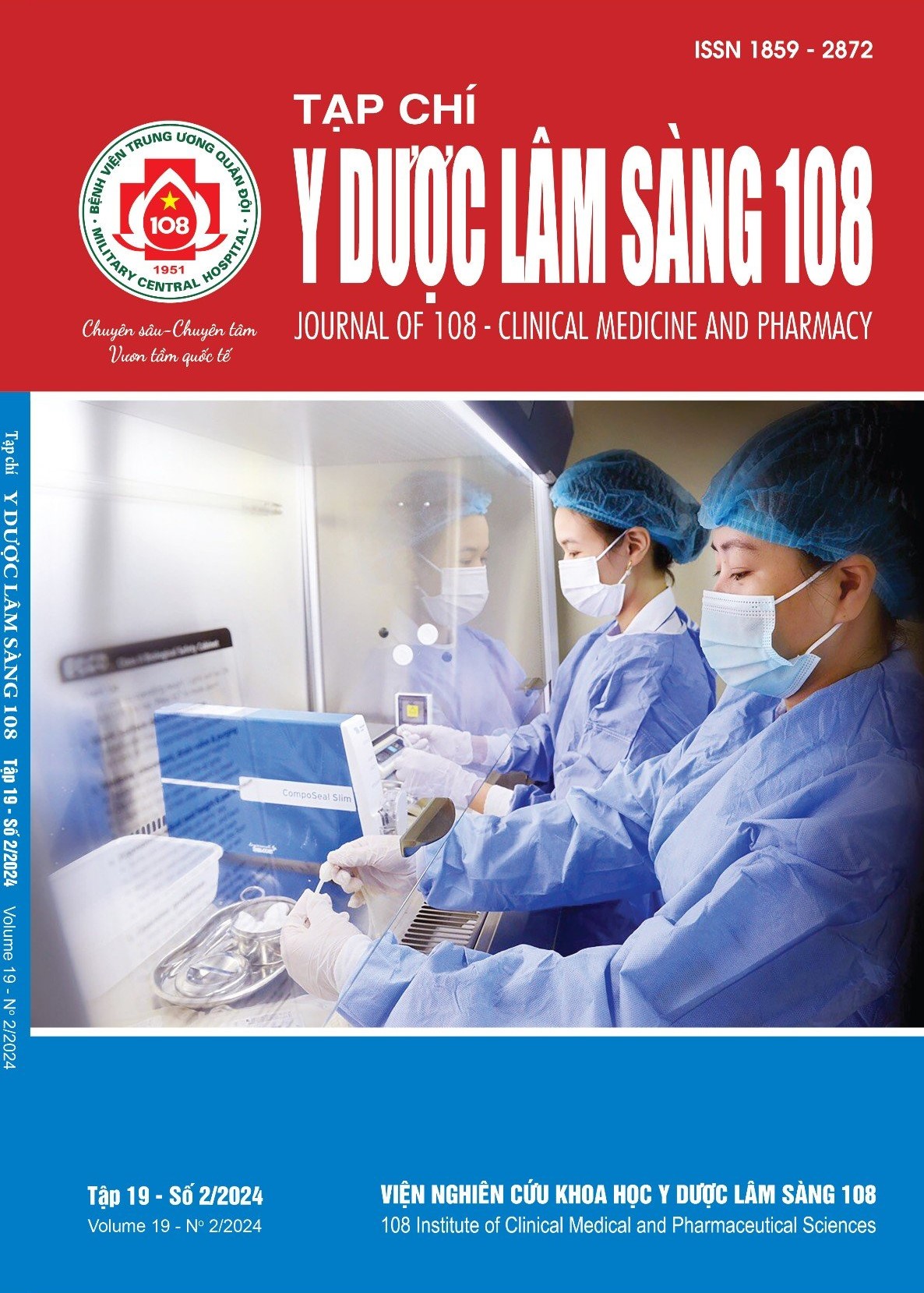Investigating the features of platelet aggregation and clopidogrel resistance in patients undergone percutaneous coronary intervention
Main Article Content
Keywords
Abstract
Objective: To study the features of platelet aggregation and the rate of clopidogrel resistance in patients undergone percutaneous coronary intervention. Subject and method: A cross-sectional descriptive study with 171 patients who were successfully stenting and treated with clopidogrel at 103 Military Hospital and 175 Military Hospital from 9/2021 to 12/2022. Platelet aggregation was determined by light transmission aggregometry with specific stimulant agent ADP. Clopidogrel resistance was determined when the maximal platelet aggregation was > 50%. Result: The average age of men
(59.91 ± 11.11) was lower than that of women (68.21 ± 9.3) with p<0.05. The rate of female patients with diabetes (39.53%) was higher than that of men (22.65%) with p<0.05. Platelet aggregation in the smoking patient group was higher than the non-smoking group (51.48 ± 15.07% vs 44.11 ± 15.09%, p<0.05), at the same time in the patient group with NT-proBNP level ≥ 300pg/ml had higher platelet aggregation than the group with NT-proBNP level < 300pg/ml (50.54 ± 15.89% vs. 43.7 ± 14.45%, p<0.05). Platelet aggregation showed a weak positive correlation with BMI (r = 0.24) and total stent length (r = 0.15) with p<0.05. The clopidgrel resistance rate was 43.68%. In the group of patients who smoked or had BMI ≥ 23kg/m2 or had NT-proBNP levels ≥ 300pg/ml, the clopidogrel resistance rate was higher than the other group with p<0.05. Conclusion: Platelet aggregation in the group of patients who smoked or had NT-proBNP levels ≥ 300pg/ml was higher than the other groups, and correlated positively with BMI and the number of stents treated. The clopidogrel resistance rate was 43.68%. In the group of patients who had BMI ≥ 23kg/m2 or smoked or had NT-proBNP levels ≥ 300pg/ml, the rate of clopidogrel resistance was higher than in the other groups with p<0.05.
Article Details
References
2. Thygesen K, Alpert JS, Jaffe AS et al (2018) Fourth universal definition of myocardial infarction. European Heart Journal 40(3): 237-269.
3. Knuuti J, Wijns W, Saraste A et al (2020) 2019 ESC Guidelines for the diagnosis and management of chronic coronary syndromes. Eur Heart J 41(3):
407-477.
4. Lawton JS, Tamis-Holland JE, Bangalore S et al (2022) 2021 ACC/AHA/SCAI Guideline for Coronary Artery Revascularization: A Report of the American College of Cardiology/American Heart Association Joint Committee on Clinical Practice Guidelines. Circulation 145(3): 18-114.
5. Hwang SJ, Jeong YH, Kim IS et al (2011) The cytochrome 2C19*2 and *3 alleles attenuate response to clopidogrel similarly in East Asian patients undergoing elective percutaneous coronary intervention. Thromb Res 127(1): 23-28.
6. Mohammadi SS, Zibaeenezhad MJ, Sayadi M et al (2021) The Impact of smoking on clinical outcomes after percutaneous coronary intervention in women compared to men. J Interv Cardiol 2021:6619503. doi: 10.1155/2021/6619503.
7. Đào Văn Đôn (2020) Nghiên cứu các yếu tố ảnh hưởng đến hiệu quả chống kết tập tiểu cầu của Clopidogrel trong điều trị hội chứng mạch vành cấp. Luận án Tiến sĩ Y học.
8. Trần Thị Hải Hà (2017) Nghiên cứu biến đổi độ ngưng tập tiểu cầu, số lượng tiểu cầu, nồng độ Fibrinogen ở bệnh nhân đau thắt ngực ổn định được can thiệp động mạch vành qua da có sử dụng Clopidogrel. Luận văn Tiến sĩ y học.
9. Redfors B, Chen S, Généreux P et al (2019) Relationship between stent diameter, platelet reactivity, and thrombotic events after percutaneous coronary artery revascularization. Am J Cardiol 124(9): 1363-1371.
10. Doğan A, Kahraman S, Usta E et al (2016) Effect of obesity and serum leptin level on clopidogrel resistance. Turk Kardiyol Dern Ars 44(7): 548-553.
 ISSN: 1859 - 2872
ISSN: 1859 - 2872
